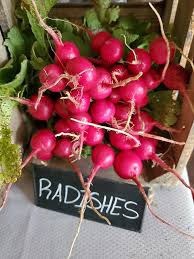Next time you’re at the Farmer’s Market, pick up a bunch of radishes. They’re cheap, you usually get about a dozen in a bunch, there are not a lot of recipes for them in cooking, and some can be fairly pungent.
But they’re fun! And colorful in salads. Since they are really about 95 per cent water, they aren’t filled with all the vitamins and minerals that are so great for eye and heart health. But they aren’t bad for you either, have practically no calories and, like all vegetables, no fat.
And if you’re not a gardener but want to grow your own veggies, it’s the perfect one with which to start. In fact, in the northeast, you could probably plant some seeds now and get a bunch before cooler weather sets in, they grow so fast. Which makes them perfect for youngsters who want to start their own gardens. It doesn’t take a lot of patience to wait to see the plants pop up from the earth.
Actually the radish is a flowering plant in the mustard family. It’s called a root vegetable because that’s what the colorful part is, the root, the only part of the plant most folks think is edible.
But even the green leafy plant is great washed well, chopped and placed in salads. There’s no waste in a radish!
In salads, radishes are the raw, crunchy vegetable with a pungent, spicy flavor, varying in intensity depending on its growing environment. They come in all sizes, flavors, color, and length of time it takes to grow and mature. That’s because of the various chemical compounds produced by the plants.
While it’s growing, the radish is helpful to most of its neighbors. Because of that pungency, there are few pests or illnesses that actually like to hang around them. So they’re often planted next to vegetables or fruits that are frequently attacked, their sharpness keeping the bad things away from their neighbors as well. Cucumbers and tomatoes love to have them as growing neighbors, as do lettuce and peas and even the herb chervil.
Radishes have been around a long time, but don’t have much history. Today, they are grown around the world, but there are few archeological records to let us know where they started out life or when. We do know both Greek and Roman writers talked about them in the first century. As far as North America, radishes probably came over here along with the first Europeans seeking new land. There have been stories by other ancients that they are a great medicine, or a poison, or even a vegetable cooked with ostrich meat. But they are more fables than proven facts.
What is true is that they’re easy to grow from seed, are annual, germinate in three or four days and mature in three to four weeks, They like full sun and sandy soils, and once harvested, they last several days in room temperature, or a couple of months refrigerated.
As far as their leaves go, try them in salads! They add a different kind of flavor that’s hard to identify but your taste buds know something special has been added. Add them to soups, or saute them and serve as a side dish, or simply use them as a garnish.



